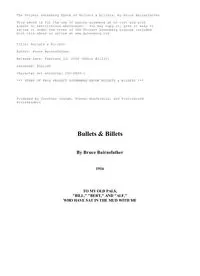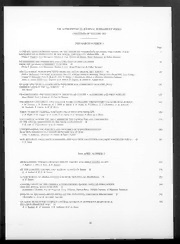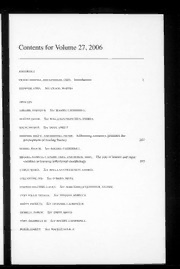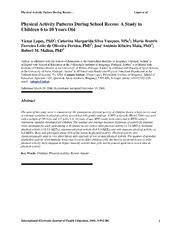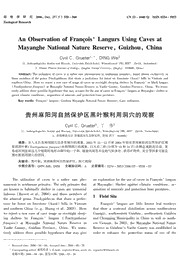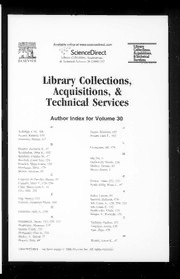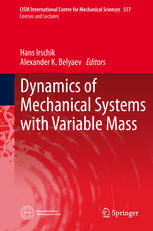
Dynamics of Mechanical Systems with Variable Mass PDF
Preview Dynamics of Mechanical Systems with Variable Mass
CISM International Centre for Mechanical Sciences 557 Courses and Lectures Hans Irschik Alexander K. Belyaev Editors Dynamics of Mechanical Systems with Variable Mass International Centre for Mechanical Sciences CISM Courses and Lectures Series Editors: The Rectors Friedrich Pfeiffer - Munich Franz G. Rammerstorfer - Wien Elisabeth Guazzelli - Marseille The Secretary General Bernhard Schre(cid:193) er - Padua Executive Editor Paolo Sera(cid:192) ni - Udine The series presents lecture notes, monographs, edited works and proceedings in the (cid:192) eld of Mechanics, Engineering, Computer Science and Applied Mathematics. Purpose of the series is to make known in the international scienti(cid:192) c and technical community results obtained in some of the activities organized by CISM, the International Centre for Mechanical Sciences. International Centre for Mechanical Sciences Courses and Lectures Vol. 557 For further volumes: www.springer.com/series/76 Hans Irschik · Alexander K. Belyaev Editors Dynamics of Mechanical Systems with Variable Mass Editors Hans Irschik University of Linz, Austria Alexander K. Belyaev Russian Academy of Sciences, St. Petersburg, Russia ISSN 0254-1971 ISBN 978-3-7091-1808-5 ISBN 978-3-7091-1809-2 (eBook) DOI 10.1007/ 978-3-7091-1809-2 Springer Wien Heidelberg New York Dordrecht London © CISM, Udine 2014 This work is subject to copyright. All rights are reserved by the Publisher, whether the whole or part of the material is concerned, speci(cid:192) cally the rights of translation, reprinting, reuse of illustrations, recitation, broadcasting, reproduction on micro(cid:192) lms or in any other physical way, and transmission or information storage and retrieval, electronic adaptation, computer software, or by similar or dissimilar methodology now known or hereafter developed. Ex- empted from this legal reservation are brief excerpts in connection with reviews or scholarly analysis or material supplied speci(cid:192) cally for the purpose of being entered and executed on a computer system, for exclusive use by the purchaser of the work. Duplication of this pub- lication or parts thereof is permitted only under the provisions of the Copyright Law of the Publisher’s location, in its current version, and permission for use must always be obtained from Springer. Permissions for use may be obtained through RightsLink at the Copyright Clearance Center. Violations are liable to prosecution under the respective Copyright Law. The use of general descriptive names, registered names, trademarks, service marks, etc. in this publication does not imply, even in the absence of a speci(cid:192) c statement, that such names are exempt from the relevant protective laws and regulations and therefore free for general use. While the advice and information in this book are believed to be true and accurate at the date of publication, neither the authors nor the editors nor the publisher can ac- cept any legal responsibility for any errors or omissions that may be made. The publish- er makes no warranty, express or implied, with respect to the material contained herein. All contributions have been typeset by the authors Printed in Italy Printed on acid-free paper Springer is part of Springer Science+Business Media (www.springer.com) PREFACE This Book is a result of the Advanced School entitled “Dynamics of Mechanical Systems with Variable Mass”, which took place in the International Centre for Mechanical Sciences (CISM), Udine, Italy, in September 2012. The fundamental equations of classical mechanics were originally formulated for the situation that mass is conserved in the mechanical system under consideration. Mass is generally not conserved when a supply of mass is present, or when open systems with a flow of mass through their surface are to be considered. Mass of the mechanical system then is said to be variable. In such a situation, the general methodological approaches of mechanics have to be properly modified. In fluid mechanics, open systems are encountered when studying a non-materialcontrolvolume. Insolidmechanics, systemswithavari- able mass appear as the result of a problem-oriented modelling, e.g., when mass is expelled or captured by a structure or machine. This again leads to the treatment as an open system, or to the assumption that mass is explicitly dependent on the position. In solid mechan- ics as well as in fluid mechanics, it is often appropriate to model the exchange of mass between the system under consideration and the environmental world by means of a supply of mass in the interior. This is of particular interest in the continuum theory of mixtures, for which mass and other entities are exchanged between the various components. It is the goal of the book to present up-to-date and unifying for- mulations for treating the dynamics of different types of mechanical systems with variable mass. The book is opened with an overview of the continuum mechanics relations of balance and jump for open sys- tems. Afterwards, at the level of analytical mechanics, extended La- grange and Hamiltonian formulations approaches are presented. The dynamics of multi-body mechanical systems with a continual and dis- continual variation of mass is treated in detail. Another chapter is devoted to axially moving structures, like belts and chains, and on pipes with an axial flow of fluid, where the stability of motion is also considered. Constitutive relations appearing in the dynamics of me- chanical systems with variable mass are studied with particular refer- ence to the modelling of multi-component mixtures, in which damage of steel structures in the form of hydrogen diffusion is also addressed. Last not least, fluid-structural coupling is studied, where novel finite element formulations for open systems are presented. As a whole, the book should be of interest not only in the fields of civil and mechanical engineering, but also in mechatronics. In more detail, the material presented in the book is organized as follows. In the introductory Chapter by H. Irschik and A. Humer, a rational treatment of the relations of balance and jump for mechani- cal systems with a time-variable mass and other non-classical supplies is presented. This presentation starts from the proper extensions of the fundamental relation of balance of mass, linear and angular mo- mentum, and total energy. Relations for balance of moment of mo- mentum, intrinsic spin, translational and rotational kinetic energy, and internal energy are derived afterwards, as mathematical conse- quences of the former fundamental relations. First, a single mass point with an intrinsic spin is treated, which then is extended to a deformable body with a finite extension, where special emphasis is laid upon the consequences of balance of mass and linear momentum. Center-of-mass oriented formulations are presented in some detail, a formulation for non-classical supplies in extension of the so-called Meshchersky reaction force is given, and a specialization to rigid bod- ies with a surface growth is studied. Continual variations of mass due to both, sources of mass in the interior and a flow of mass through the surface of a non-material control volume are studied, and analogies between these two cases are worked out. Jump relations for the case that a singular surface is travelling through the variable mass system are presented in an extended form, which takes into account concen- trated surface supplies. The Cayley example of a chain hanging over the edge of the table and set into motion is used as an illustrative example. In the following Chapter by C.P. Pesce and L. Casetta, the impor- tant case of variable mass systems, in which mass explicitly depends onposition, andthusisvariableinthecourseofthemotion, isstudied from the point of view of analytical mechanics. It is pointed out that for this case the Lagrange equation has to be carefully re-interpreted, since an extra non-conservative generalized force term, linearly pro- portional to the mass gradient and quadratic on velocities, turns out to emerge from first variational principles. In this chapter, a cor- rect extended form of the Lagrange equation is derived through the Lagrangean and Hamiltonian approaches, and is discussed in detail. Various illustrative and practical examples from offshore engineering and civil engineering are presented, such as the reel laying opera- tion of marine cables, the dynamics of a water column inside a free surface piercing open pipe, and the hydrodynamic impact of a solid body against a free surface of water. Also, the governing equation of motion of vertically collapsing towers is properly derived in the framework of the extended Lagrange equation. The Chapter by L. Cveticanin addresses the dynamics of the body with time variable mass and time variable moment of inertia. The discontinual and the continual cases of variations of mass and mo- ment of inertia are considered. The basic laws of dynamics are ex- tended to the case in which the mass is varying in time. The princi- ples of momentum and angular momentum are applied to obtain the velocity and angular velocity of the body after discontinual mass vari- ation. The dynamics of mass addition is treated as the plastic impact. In addition to the reactive force, the reactive torque is introduced for the case of the continual time-variation of the mass and the moment of inertia. The free motion and the vibration of the mass variable body are treated as special cases. The influence of the reactive force on the vibration properties of the body is analyzed. The Chapter prepared by D. Indeitsev and Yu. Mochalova deals with the dynamics of the material with complex internal structure. A two-component continuum model is utilised to this end. The ap- proach allows one to describe the internal evolution processes in ma- terials basing on the Euler equations and the mass balance equations containing the source terms is proposed. The influence of exchange mass between the components on the internal structure of the mate- rials is investigated. The source terms determining the mass transfer between material components are defined. The following examples are delivered: the structured liquids in nanochannels, the metals with impurities and dissolved hydrogen. The Chapter by A. Zilian is devoted to mechanics of coupled sys- tems with mass which is dependent on structural motion and defor- mation; the effects of added mass, damping, stiffness; the models for fluid-structure interaction of discrete and distributed mass sys- tems. In this contribution, concepts for modelling the interaction of structures and fluids are presented. Starting from excitation mecha- nisms and associated classifications, various model depth approaches are compared. Among them, the use of added coefficients for quasi- steady problems is discussed. On the basis of potential flow theory, thedifferentapproachesfordeterminingfluid-inducedadditionalmass are established and illustrated by using an analytical example. Given the limitations of simplifying the engineering models, the second part of the chapter provides a brief overview on computational methods forfluid-structureinteractionandpresentsamonolithicmodellingap- proach using space-time finite elements for discretisation of both fluid and structure. Applications from aero- and hydro-elasticity show the applicability of computational methods for problems involving flow- induced added mass, damping, and stiffness. The Chapter by A.K. Belyaev is predominantly concerned with a special case of dynamics of the engineering systems with variable mass, namely open systems with moving continua. A characteris- tic feature of these systems is that a material enters the system and leaves the system. The transported material itself is assumed to be deformable and under some conditions the entire system exhibits un- stable behaviour in the transverse direction. The intent of the present chapter is to demonstrate that the systems with axially moving ma- terial are inherently unstable. Dynamics and stability are known to be strongly related to each other, for this reason the study of dynam- ics and stability for each engineering system under consideration is carried out in the framework of the same approach. The chapter is opened with a general discussion and notion of the static and dy- namics stability. A number of special cases important for mechani- cal engineering are considered. Some of these belong to the class of problems of fluid-structure interaction, in particular, dynamics and stability of the fluid conveying pipes and the shaft rotating in oil film plain bearings. The dynamics and stability of belts and chains are studied in detail, too. It is a great pleasure for the editors to acknowledge the signifi- cant contributions made to the CISM Advanced School “Dynamics of Mechanical Systems with Variable Mass” and to this book by Pro- fessors Livija Cveticanin from Serbia, Dmitry Indeitsev from Rus- sia, Celso Pesce from Brazil and Andreas Zilian from Luxembourg. They delivered excellent lectures in Udine in September 2012, and they contributed chapters to this book making our joint project a truly international effort. We also wish to thank them for their invaluable contributions. The school brought together of about 40 participants from 7 coun- tries. We are grateful to all participants for their interest and the numerous discussions that took place during and after the lectures. We are particularly thankful to the Scientific Council of CISM for supporting this Advanced School and recognizing the importance of the topic. The continuous support of the co-operation of the under- signed Editors in the framework of the Austrian Comet K2-Center of Excellence in Mechatronics ACCM is gratefully acknowledged. Hans Irschik and Alexander K. Belyaev
The list of books you might like

The 48 Laws of Power

The Subtle Art of Not Giving a F*ck

The Spanish Love Deception

Shatter Me Complete Collection (Shatter Me; Destroy Me; Unravel Me; Fracture Me; Ignite Me)

NYT 2020-03-31 UserUpload Net

Blume, Heinrich Das politische Gesicht
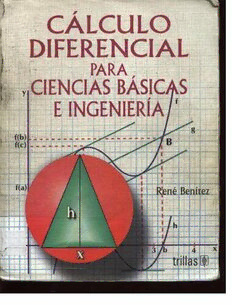
Cálculo Diferencial para Ciencias Básicas e Ingeniería
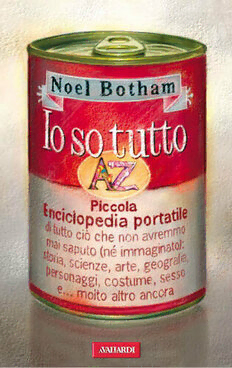
Io so tutto: Piccola enciclopedia portatile di tutto ciò che non avremmo mai saputo
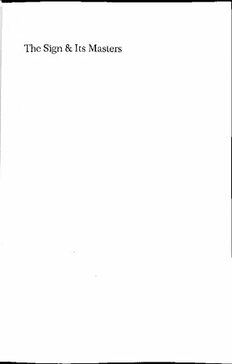
The sign & its masters

Negro zine 2 (2006 Apr)
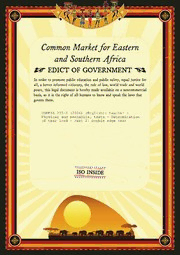
COMESA 235-2: Leather - Physical and mechanical tests - Determination of tear load - Part 2: Double edge tear
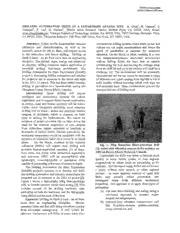
NASA Technical Reports Server (NTRS) 20060026170: Drilling Automation Tests At A Lunar/Mars Analog Site

DTIC ADA599379: Helicopter Dynamic Components Project
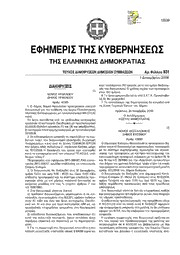
Greek Government Gazette: Part 7, 2006 no. 831

BIO-SECURITY COORDINATION
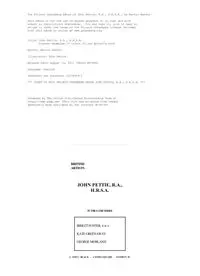
British by AUTHOR

C.A. No. 12088-12089/2018
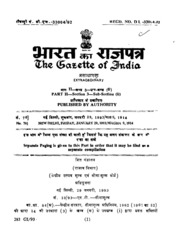
Union Government, Extraordinary, 1993-01-29, CSL, Ref. CSL
